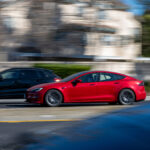A combined forward collision and lane departure warning system available on the Honda Accord is reducing insurance claims, a new analysis by the Highway Loss Data Institute (HLDI) shows. The results are even better than expected based on previous studies of such technology on luxury vehicles. HLDI is an affiliate of the Insurance Institute for Highway Safety.
In the first real-world study of a crash avoidance system on a high-volume, nonluxury vehicle, Honda’s system was found to reduce insurance claims for damage to other vehicles by 14 percent. It cut claims for injuries to occupants of the equipped vehicles by 27 percent and claims for injuries to other road users by 40 percent.
“This was our first opportunity to study advanced crash avoidance technology on a high-volume vehicle, and the results are impressive,” says HLDI Vice President Matt Moore. “This is a warning system only, but the claim frequency reductions are similar to what we saw earlier for systems with automatic braking.”
Previous analyses of forward collision warning without autobrake showed more modest claim reductions. Lane departure warning was associated with increases in claims in earlier studies, though none that were statistically significant.
Advanced crash avoidance technologies first appeared on luxury vehicles but now are being offered as options on mainstream cars and SUVs. IIHS provides front crash prevention ratings for many models, and a basic or higher rating is a requirement for the Institute’s highest award, TOP SAFETY PICK+. A forward collision warning system like the Accord’s that meets government criteria qualifies for a basic rating. Systems that include an autobrake function can earn an advanced or superior rating, based on performance in two IIHS track tests.
For the study of the Honda features, HLDI looked at both 2-door and 4-door versions of the 2013 Accord, as well as the 2013 Crosstour, an SUV built on the Accord platform. The crash avoidance features are standard on certain trim levels. Losses under different types of insurance were compared for Accords and Crosstours with and without the features.
The rate of property damage liability (PDL) claims was 14 percent lower for vehicles with forward collision and lane departure warning than for those without. PDL covers damage caused by the insured vehicle to someone else’s vehicle or property. Claims for front-to-rear crashes that forward collision warning systems are intended to address are common for this type of insurance, and previous studies of front crash prevention systems found statistically significant reductions in PDL claim frequency.
In the earlier studies, forward collision warning systems without autobrake from Mercedes-Benz and Volvo resulted in PDL frequency reductions of 7 percent. Systems that included autobrake had reductions of 10-14 percent.
The impressive results for a system that lacks autobrake could mean that Honda’s forward collision warning works better than the warning systems evaluated earlier. Another possible explanation is that the Honda lane departure warning component is providing a benefit, unlike lane departure warning systems from Buick and Mercedes-Benz that were studied in 2012. In the earlier studies, only Volvo’s lane departure warning was associated with PDL claim frequency reductions, but it was combined with forward collision warning with autobrake, and the effect wasn’t statistically significant. Forward collision warning is still relatively new, so the benefits of the various systems may turn out to be more similar to one another after additional data are collected.
Claim frequency under collision coverage, which pays for damage to the insured vehicle, was 4 percent lower with Honda’s warning system, though the reduction wasn’t statistically significant. Effects on collision claims would be expected to be weaker than the effects on PDL because collision claims include many single-vehicle crashes that wouldn’t be addressed by the technology. That pattern was observed in the earlier analyses of front crash prevention systems as well.
Notably, collision claim severity, or average loss payment per claim, fell by $409 with the warning system. This indicates that many crashes that aren’t prevented by the feature are mitigated. Previously studied warning systems didn’t show declines in collision severity, and the difference may have to do with the location of the equipment on the vehicle. Honda’s system relies on a camera located inside the vehicle, while the other systems use external radar sensors that can be easily damaged, pushing up repair costs in crashes that aren’t avoided.
Injury claim frequencies also fell with the warning system. Bodily injury liability coverage, which pays for injuries to occupants of other vehicles or other people on the road, declined 40 percent. Medical payment insurance, which covers injuries to occupants of the insured vehicle, fell 27 percent. Personal injury protection, which is sold in states with no-fault insurance systems and covers injuries to occupants of the insured vehicle regardless of who is at fault, fell 11 percent, but the result wasn’t statistically significant.
Source: HLDI
Was this article valuable?
Here are more articles you may enjoy.

 Verisk: Claims Volume Rose 36% in 2024, Largely on Catastrophe Claims
Verisk: Claims Volume Rose 36% in 2024, Largely on Catastrophe Claims  Tesla a Step Closer to Ride-Hailing With California Permit
Tesla a Step Closer to Ride-Hailing With California Permit  Cybersecurity Officials Warn of Potentially Costly Medusa Ransomware Attacks
Cybersecurity Officials Warn of Potentially Costly Medusa Ransomware Attacks  Ineos Recalls 7,000 SUVs After Doors Fly Open While Driving
Ineos Recalls 7,000 SUVs After Doors Fly Open While Driving 